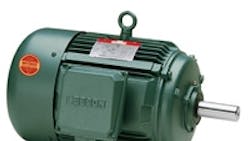Going green with highly efficient motors
The Energy Independence and Security Act (EISA) goes into effect December 19, 2010, and has far-reaching implications for many industries. The act has numerous goals and mandates — 300 pages worth — and includes new laws to increase the efficiency of a wider range of motors than ever before. The law affects all engineers that specify or purchase electric motors, as well as those responsible for motor-powered plant operations.
Industrial electrical motors:
-
Consume about 65% of generated electrical energy
-
Account for up to 75% of total electricity costs in industrial plants
-
Use 50% of total electricity consumed by commercial buildings
In addition, the annual cost of operating an electric motor can reach 25 times its purchase cost.
Previous energy policies
EISA is the most recent Act in a series of energy-saving, motor-related laws to go into effect over the past 20 years — each increasing the efficiency parameters of a previous version.
Beginning in 1992, the Energy Policy Act (EPAct 92) affected motors commonly specified for industrial equipment, establishing minimum efficiency standards for industrial electric motors built after October 1997. Next came the Energy Policy Act of 2005 (EPAct 2005), which established specific efficiency requirements for federal motor purchases. EPAct 2005 covers the same motor types listed in EPAct 92, plus other motors from 1 to 500 hp.
EISA further expands coverage and increases the minimum requirements, regulating new motor purchases made after December 19, 2010. Existing motors are grandfathered and can be rebuilt as usual, though as we'll explore, rebuilding is often a wasteful choice.
Energy-efficient motors
Electric motors, introduced more than 100 years ago, quickly became the gold standard for mechanical power generation, revolutionizing industrial applications and greatly improving their efficiency. Today's efficient motors have reconfigured rotors and fan blades plus advanced superconducting materials. One drawback is initial purchase cost: EISA-compliant motors cost more than older designs. Sometimes engineers are also skeptical about manufacturer performance claims.
However, the capital cost of any motor is low compared with the cost of the electricity used to run it. A $2,000 motor, for example, might consume $50,000 worth of electricity over its lifetime. For this reason, energy-efficient motors make economic sense: In an industrial application operating 4,000 hours/year, energy-efficient motors earn back their initial cost in two years.
Premium-efficiency motors also run at lower operating temperatures — which extends life for the motor's insulation, copper windings, and bearings. Less waste heat in turn reduces ventilation requirements, resulting in additional energy savings.
One excellent book on the topic is Energy-Efficient Motor Systems: A Handbook on Technology, Program, and Policy Opportunities. Of interest to engineers and facilities managers is the book's comprehensive overview of the latest technology options. The book's second edition outlines a systems approach encompassing efficient motors, optimized controls, component sizing, repair, and transmission hardware, plus more comprehensive monitoring and maintenance. Full application of the measures described would cut U.S. electricity demand by 27 to 40%, save motor users and utilities billions of dollars, reduce pollutant emissions, and enhance productivity.
For more information, visit LEESON Electric (of Regal-Beloit Corp.) at leeson.com.
Winds of change: Efficient motors trim turbine maintenance
Renewable sources supply less than 10% of the energy consumed in the United States, but we are now the largest harvester of wind energy in the world, and there's rising demand for green energy. For this reason, wind-turbine manufacturers in particular are searching for solutions to make their turbines more efficient and reliable.
A wind turbine's major components include rotor blades, gearbox, and generator. Servicing these parts is expensive because turbine towers can be 200 feet tall or higher. Here, energy-efficient motors (for generation) help reduce maintenance and boost efficiency when sending the output to power grids.
